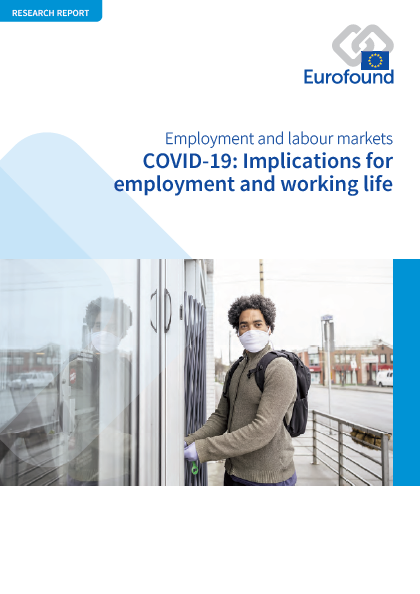
Disclaimer - Please note that this report was updated with revised data (specifically for Bulgaria) on 23 March 2021.
This report sets out to assess the initial impact of the COVID-19 crisis on employment in Europe (up to Q2 2020), including its effects across sectors and on different categories of workers. It also looks at measures implemented by policymakers in a bid to limit the negative effects of the crisis. It first provides an overview of policy approaches adopted to mitigate the impact of the crisis on businesses, workers and citizens. The main focus is on the development, content and impact of short-time working schemes, income support measures for self-employed people, hardship funds and rent and mortgage deferrals. Finally, it explores the involvement of social partners in the development and implementation of such measures and the role of European funding in supporting these schemes.
Key findings
In the 12 months leading up to Spring 2020, EU employment declined by 2.4%, the weekly hours of those still in work dropped by nearly one hour and the share of workers employed but not working more than doubled to 17%. By July 2020, nearly 50% of EU workers had moved to exclusive or partial telework, opening up new labour market gulfs as the more highly educated and those in urban areas were better placed to work from home.
Young people experienced the sharpest decline in employment, while prime-aged workers (25–54 years) and older male workers have been most likely to see their working hours cut. The need to avoid another ‘lost generation’ of young people must be a priority for policymakers when designing active labour market policies to mitigate the fallout from the crisis.
Workers with precarious employment conditions have been particularly exposed to job losses because of the pandemic: the number of temporary contracts in the EU27 shrank by 17% between spring 2019 and spring 2020, accounting for well over three-quarters of the decline in aggregate EU employment.
Short-time working or similar schemes to protect employment have buffered the impact of COVID-19 on the labour market, but the scope and level of income protection offered varies significantly between countries. Establishing permanent short-time working or similar systems that can be activated in crisis situations and allow for the structural adjustment of economies and human resources will be critical, as well as the strong involvement of social partners and other stakeholders in these schemes to prevent unforeseen exclusion in relation to eligibility and other anomalies.
The COVID-19 crisis has provided an impetus in most countries to extend income protection to groups not previously protected. However, the level of support granted to the self-employed often falls short of the protection provided to workers as the eligibility criteria introduced included sectoral restrictions, limitations to certain groups of self-employed and requirements to meet income reduction thresholds.
This publication contains the following list of tables and figures.
List of tables
- Table 1: Changes in employment, hours worked and share not working by country, Q2 2019–Q2 2020, EU27
- Table 2: Changes in employment, hours worked and share not working by age and gender, Q2 2019–Q2 2020, EU27
- Table 3: Sectors most and least affected by the crisis (NACE Rev. 2), Q2 2019–Q2 2020, EU27
- Table 4: Changes in employment, hours worked and share not working by occupation, Q2 2019–Q2 2020, EU27
- Table 5: Jobs with the biggest employment losses by gender, Q2 2019–Q2 2020, EU27
- Table 6: Categorisation of mitigation measures
- Table 7: Categories of employment protection schemes, September 2020
- Table 8: Amendments made to new and existing schemes after their initial introduction by type of amendment, September 2020
- Table 9: Reasons for reduced working hours/workforce requirements, September 2020
- Table 10: Workers eligible for employment protection schemes (in addition to those on standard contracts), September 2020, EU27
- Table 11: Eligibility criteria in terms of turnover reduction and share of workforce affected, September 2020
- Table 12: Duration of protection from dismissal following use of employment protection schemes, September 2020
- Table 13: Overall budget foreseen and amounts expended between March and September 2020
- Table 14: SURE support measures for self-employed people, November 2020
- Table 15: Level of income support for self-employed people, September 2020
- Table 16: Take-up, budget and budget utilisation in March–September 2020
- Table 17: Change in self-employment in different NACE Rev. 2 sectors, Q2 2019–Q2 2020, EU27
- Table 18: Social assistance interventions by type and duration
- Table 19: Level of involvement of social partners in employment protection measures, September 2020
List of figures
- Figure 1: Employment levels, Q1 2018–Q2 2020, EU27 (millions of workers)
- Figure 2: Labour market transitions, Q1 2020–Q2 2020, EU26*
- Figure 3: Change in employment, Q2 2019–Q2 2020, EU27 (%)
- Figure 4: Share of workers working from home during the crisis, April and July 2020, EU27 (%)
- Figure 5: Incidence of telework (%) and self-reported likelihood of job loss, April 2020, EU27
- Figure 6: Employment shifts by job–wage quintile: Two crisis periods compared, EU27
- Figure 7: Employment shifts by gender and job–wage quintile: Two crisis periods compared, EU27
- Figure 8: Distribution of policy measures by category, October 2020, EU27 (%)
- Figure 9: Focus of interventions in the most commonly implemented categories of measures, October 2020, EU27 (% of total measures in that category)
- Figure 10: Maximum replacement rates available through employment protection schemes, March–September 2020 (% of previous salary)
- Figure 11: Duration of support, September 2020 (months)
- Figure 12: Take-up of short-time working or temporary unemployment benefits, April 2020, EU27 (%)
- Figure 13: Take-up of short-time working schemes in economic crisis versus COVID-19 crisis, share of dependent employees, Q2 2009 and May 2020 (%)
- Figure 14: Share of workers supported by employment protection measures in selected sectors, March–August 2020 (%)
- Figure 15: Take-up of short-time working schemes (%), share of workers not working (%) and change in working hours between Q2 2019 and Q2 2020, EU27
- Figure 16: Income reductions experienced by workers receiving short-time working allowances with and without top-ups, Germany (%)
- Figure 17: Proportions of full- and part-time self-employed individuals, 2018, EU27 (%)
- Figure 18: Proportions of solo self-employed people and self-employed people with employees among total self-employment, 2019, EU27 (%)
- Figure 19: Categorisation of income replacement schemes for self-employed people, September 2020
- Figure 20: Minimum income or turnover loss required to access self-employment income support schemes, September 2020 (%)
- Figure 21: Take-up rates for income support schemes for self-employed people in March–September 2020, as share of support paid out (%)
- Figure 22: Severe housing deprivation rate in the bottom income quintile, 2019, EU27 (%)
- Figure 23: Housing cost overburden among low-income tenants, 2018 (%)
- Figure 24: Numbers of measures targeting living and housing conditions, September 2020, EU27
- Figure 25: Involvement of social partners in the design of policy measures addressing the socioeconomic impact of the pandemic, September 2020, EU27 (%)
- Number of pages
-
85
- Reference nº
-
EF20050
- ISBN
-
978-92-897-2121-9
- Catalogue nº
-
TJ-02-20-860-EN-N
- DOI
-
10.2806/024695
- Permalink
A selection of 10 data pages accompany Eurofound's report on the implications for employment and working life during the COVID-19 pandemic.
Cite this publication
Eurofound (2021), COVID-19: Implications for employment and working life, Publications Office of the European Union, Luxembourg.
